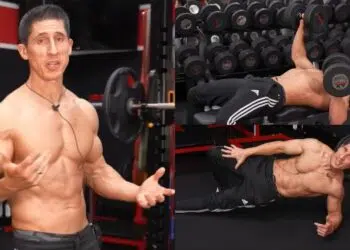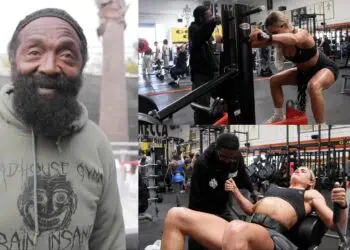Bent-over rowing exercises can be challenging for beginners as they place significant strain on the lower back. Even experienced lifters employ significant body English during rowing exercises, which removes the tension from the target muscles.
This is why I believe that implementing variations such as chest-supported T-bar rows in your workouts is crucial. The chest-supported T-bar row eliminates core muscle engagement, allowing you to focus on the upper back muscles.
Let’s start with a simple step-by-step guide about performing chest-supported T-bar rows correctly so you get the most out of the movement.
How to Do a Chest-Supported T-Bar Row
Here is how to perform this exercise with a picture-perfect form:
Step One — Assume the Starting Position
Load the T-bar with an appropriate weight. Place your feet hip-width apart on the chest-supported T-bar machine’s platform and your chest against the inclined pad. Grab the T-bar handles with an overhand grip and unrack the bar so your arms are fully extended. Ensure your head, neck, and spine are in a neutral position throughout the exercise.
Pro Tip: Retracting the scapula will allow you to follow an extended range of motion, maximizing target muscle stimulation.
Level Up Your Fitness: Join our 💪 strong community in Fitness Volt Newsletter. Get daily inspiration, expert-backed workouts, nutrition tips, the latest in strength sports, and the support you need to reach your goals. Subscribe for free!
Step Two — Pulling Phase
Pull the T-bar towards your body by flexing your elbows and driving them behind the midline. Hold the fully shortened position for one second and squeeze the upper body muscles (lats, traps, rhomboids, rear delts, and teres major and minor) as hard as possible.
Pro Tip: Keep your elbows tight to the sides on concentrics to maximize lat engagement. Exhale sharply on concentrics and breathe in on the lowering phase.
Step Three — Lowering Phase
Using a slow and controlled motion, reverse the motion to return the bar to the starting position. Slow eccentrics increase the time under tension (TUT), which can promote hypertrophy.
Pro Tip: Use lifting straps to eliminate grip strength and load the lats better.
Programming the Chest-Supported T-Bar Row
In a YouTube video, Jeff Nippard, a professional natural bodybuilder and powerlifter, discusses how to program back exercises such as the chest-supported T-bar row for maximal back gains:
“In terms of fiber type, both the lats and traps seem to be predominantly fast-twitch dominant, implying they may respond better to heavier loads, while the spinal erectors are slow-twitch dominant and respond better to lighter loads. I still think that using a variety of rep ranges [in exercises like the T-bar row] is best for maximizing overall development.”
Muscles Worked: Chest-Supported T-Bar Row
The primary muscles working during the T-bar row are the lats, traps, rhomboids, and teres major and minor.
The secondary muscles include the biceps brachii, rear deltoids, brachioradialis, and wrist extensors.
Benefits of Chest-Supported T-Bar Row
Here are the most important chest-supported T-bar advantages:
Targeted Back Development
The chest-supported T-bar row is an excellent exercise for developing the upper and middle back. It activates everything from your lats and traps to rhomboids and posterior deltoids. You can maximize back muscle hypertrophy and strength gains by implementing the progressive overload principles. (1)
Reduced Pressure on the Lower Back
Lower back strain is one of the biggest problems associated with bent-over rowing exercises, especially while lifting heavier weights. You can usually do more than your back can handle.
The chest-supported T-bar row is excellent because it alleviates pressure from your lower back and puts your torso in the perfect position for maximal lat engagement.
Perfect for Slow Eccentric Training
The chest-supported T-bar row is perfect for slow eccentric training and muscle hypertrophy because you can focus on muscle contraction without worrying about stabilizing your body. The machine provides sufficient stabilization, and you only need to focus on slowly lowering the T-bar to the starting position.
Slow eccentrics prolong the time your muscles are under tension, which has been shown to be excellent for muscle hypertrophy and even strength. (2)
Great for Beginner Lifters
The chest-supported T-bar row is great for beginner lifters because it allows you to build a base level of pulling strength safely and efficiently.
Your lumbar spine is safe and supported by the pad, which reduces the pressure on the erector spinae muscles.
Level Up Your Fitness: Join our 💪 strong community in Fitness Volt Newsletter. Get daily inspiration, expert-backed workouts, nutrition tips, the latest in strength sports, and the support you need to reach your goals. Subscribe for free!
Variations & Alternatives of the Chest-Supported T-Bar Row
Here are the best chest-supported T-bar row variations and alternatives to consider:
Chest-Supported Dumbbell Row
The chest-supported dumbbell row is one of the best T-bar variations for developing your upper back muscles. However, the dumbbells will add an element of instability, requiring your stabilizer muscles to get activated, making it more functional in that sense.
Steps:
- Set the back of the incline bench to a 30 to 45-degree angle.
- Pick two dumbbells of appropriate weight.
- Place your chest flat against the back pad.
- Your arms should be perpendicular to the floor in the starting position.
- Ensure a firm stance for added balance and stability.
- Row the dumbbell toward your hips by flexing your elbows and lifting them toward the ceiling.
- When the dumbbell reaches the level of your hips, hold that position for one second.
- Reverse the motion to return the dumbbells to the starting position and repeat.
Pro Tip: Experiment with varying your grip width or orientation (such as switching between a neutral and pronated grip). This will help bias different upper back muscles and develop a more balanced physique.
Chest-Supported Barbell Row
The chest-supported barbell row is very similar to the dumbbell row variation. However, it requires less stabilizer muscle activity and a limited range of motion.
Steps:
- Set the back pad of the incline bench to a 30 to 45-degree angle.
- Place the barbell below the incline bench and load it with the appropriate weight.
- Lie on the incline bench with your chest, and ensure your head is in a neutral position and your feet are firmly placed on the ground for added stability.
- Grip the barbell just outside shoulder-width with a pronated grip.
- Row the barbell towards your belly button.
- Hold the top position for one second.
Pro Tip: Concentrate on a controlled, slow descent of the barbell to intensify the eccentric phase of the lift. This will help increase muscle hypertrophy and strength in your upper back. Also, ensure that your elbows stay close to your body throughout the motion to maximize activation of the lats and minimize unnecessary strain on your shoulders.
Bent-Over Barbell Row
The bent-over barbell row is more challenging than the chest-supported rowing variations. It requires greater stabilizer activity and is more demanding on your central nervous system (CNS).
Steps:
- Stand upright with a hip-width stance while holding a barbell with a shoulder-wide overhand grip.
- Flex your knees slightly and hinge at the hips so your torso is at 45 degrees.
- Your arms should be perpendicular to the floor.
- Row the barbell to your abdomen and hold the top position for one second.
- Now, slowly lower the barbell to the starting position and repeat the whole process.
Pro Tip: Keep your torso as close to the floor as possible. This position optimizes the engagement of your lats and mid-back muscles, providing a deeper contraction.
Single-Arm Kettlebell Row
The single-arm kettlebell row is one of my favorite unilateral exercises because it builds real-world functional strength and allows for a greater range of motion.
Steps:
- Pick an appropriately sized kettlebell.
- Place a flat bench in front of you.
- Hold the kettlebell in your right hand.
- Place your left hand on the bench and position your torso so it is parallel to the floor.
- Row the kettlebell in your right hand towards your right hip.
- Hold the isometric contraction for one second.
Pro Tip: To increase the challenge, perform the single-arm kettlebell rows without placing your non-working hand on the dumbbell stack. This requires your core to work harder to stabilize your body and improves overall balance and muscle coordination. Incorporate a rotational twist at the top of the row to engage the obliques, adding a functional twist to the traditional back exercise.
FAQs
What is the best grip for chest-supported rows?
In my experience, the pronated grip works the best. However, people vary in their grip preferences, so you must experiment to find the best one for your goals.
What is a good weight for a supported T-bar row?
Anything between 65% and 85% of your 1RM is perfect for developing muscle hypertrophy. Aim for a weight that allows you to perform 8-12 repetitions with good form. Since everyone’s strength varies, there’s no single weight recommendation that works for all. Choose the weight based on your 1RM and not some general weight guidelines.
Wrapping Up
The chest-supported T-bar row is one of the best back exercises for safely and efficiently improving your middle and upper back strength and size, as it provides additional stability.
The chest-supported variation allows you to use a higher training volume as it doesn’t put much pressure on your lower back.
In the comments below, let me know your thoughts on the chest-supported T-bar row and how you implement it in your back and pull-day workout routines.
References:
- Peterson MD, Pistilli E, Haff GG, Hoffman EP, Gordon PM. Progression of volume load and muscular adaptation during resistance exercise. Eur J Appl Physiol. 2011;111(6):1063-1071. doi:10.1007/s00421-010-1735-9
- Krzysztofik M, Wilk M, Wojdała G, Gołaś A. Maximizing Muscle Hypertrophy: A Systematic Review of Advanced Resistance Training Techniques and Methods. Int J Environ Res Public Health. 2019;16(24):4897. Published 2019 Dec 4. doi:10.3390/ijerph16244897
Featured image via @BENNYTHEOX on YouTube!
Relevant Articles:
Interested in measuring your progress? Check out our strength standards for Chest Supported Dumbbell Row, Upright Row, T Bar Row, and more.








